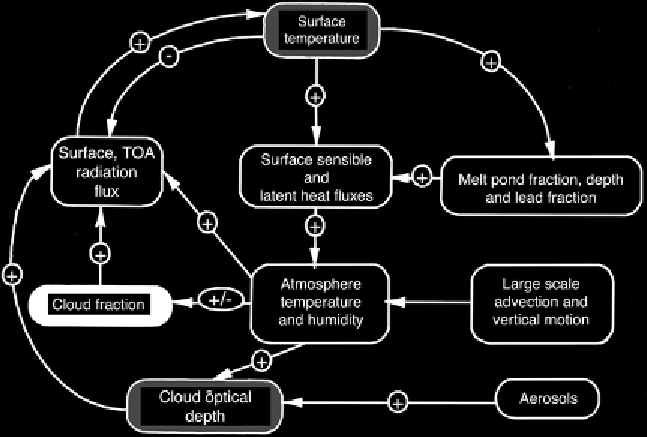Geoscience Reference
In-Depth Information
Figure 5.15.
Schematic of the ice-albedo feedback mechanism using the framework
of Kellogg (
1973
). The direction of the arrow indicates the direction in the interaction.
A “+” indicates a positive interaction (an increase in the first quantity leads to an
increase in the second). A “-” indicates a negative interaction (an increase in the first
quantity leads to a decrease in the second quantity). A “+/−” indicates that the sign of
the interaction is uncertain or that the sign changes over the annual cycle (from Curry
et al.,
1996
, by permission of AMS).
meaning greater absorption of solar radiation at the surface. The climate hence warms
more, melting more snow and ice, and so on. The mechanism can work in reverse,
whereby cooling allows more snow and ice to remain on the surface, increasing
the earth's albedo, causing further cooling. The feedback is positive in that through
the chain of events, the initial perturbation (warming or cooling) is reinforced. The
ice-albedo feedback is an important process in simulations of global warming in
response to increased concentrations of greenhouse gases (see
Chapter 11
) and to
simulations of global cooling during Ice Age maxima (see
Chapter 10
).
Although most attention has been paid to the feedback process associated with
changes in the areal extent of snow cover and sea ice, there are also feedbacks asso-
ciated with processes within the snow and ice zones. This is illustrated conceptually
for the case of the sea ice cover (
Figure 5.15
). The outer loop represents the feed-
back associated with areal extent whereby an initial perturbation (e.g., increased or
decreased ice extent) instigates a chain of events amplifying the perturbation (this
loop also holds with respect to areal changes in terrestrial snow cover). The inte-
rior part of the figure illustrates processes occurring within the multiyear ice pack.
Warming leads to more melt ponds, and more melt ponds will reduce the albedo.
Similarly, warming results in less snow cover, which reduces surface albedo. This
also means thinner ice, reducing the albedo. Albedo is also reduced with higher
temperatures because of an increase in lead fraction.

